This is a follow-up of our previous blog on how urban mobility behavior has changed during lockdown. In this blog, we look at four possible scenarios of the future for urban mobility post-lockdown. Built around actual behavior, our scenarios combine MOTIONTAG’s mobility behavior and GfK consumer behavior data with views from leading experts in the field.
Usually, people decide which mode of transport they will use based on criteria such as availability, price, convenience, time. For the foreseeable future, that decision will consider new values too – such as the perceived risk of infection and altered loyalties. Post-lockdown, this presents a unique opportunity for urban mobility and city planners to take active measures to direct our altered travel behaviors into positive, sustainable models for cities.
Future #1: No change in urban mobility post-lockdown
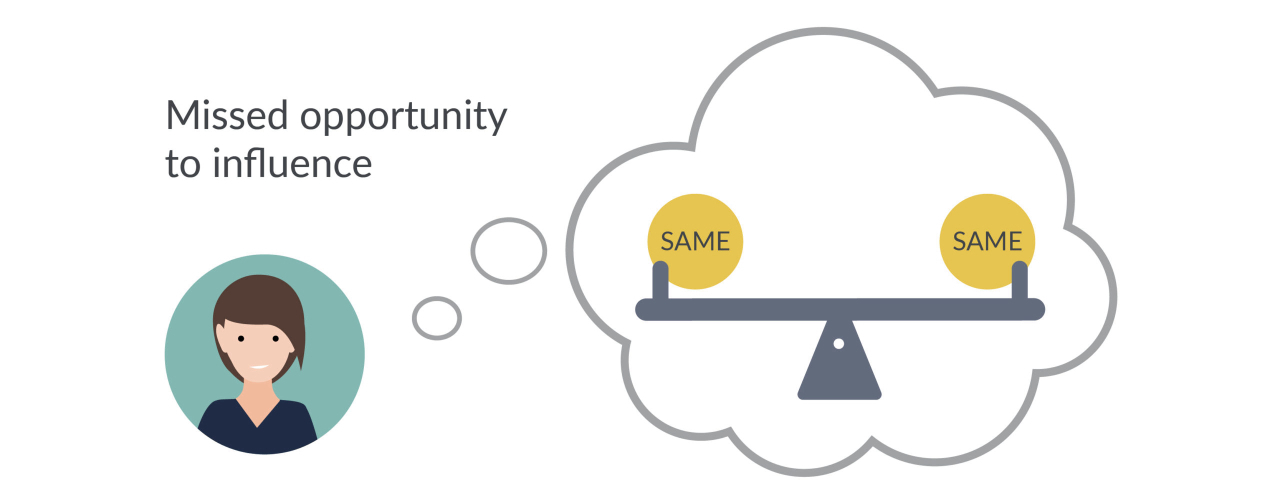
This is the most possible future if urban mobility planners do not take positive action during this time. People will go back to their pre-lockdown mobility patterns with all its flaws—but with a notable delay in re-engaging with public transport. This continued public transport avoidance will be down to three factors:
- People still wanting to avoid proximity with other people;
- The reduced need to commute due to job losses or continued remote working; and
- The summer weather encouraging people to continue their new-found love or walking or cycling to work.
The short-term implication for urban mobility in this scenario is people focusing on individual modes of transport. In addition to walking and cycling, this could mean a short-term surge in car usage, leading to increased traffic jams and pollution in urban areas. This will worsen if people who have been working remotely are forced back into commuting to the office before their fear of public infection is over.
The long-term outlook in this scenario is that people will gradually fall back into their old, anchored habits for travel and mobility. Use of public transport may even be accelerated as job losses and economic downturn push people towards lower-cost options rather than running their own car. Our data already shows that consumers increasingly see now as a bad time to make a major purchase so the number of people buying a new or second-hand car is likely to drop considerably.
But would we choose either of these views if we were given the choice? Probably not. Instead of letting things go back to how they were before—with all the problems of congestion and pollution—urban mobility planners can grip this time of shifting travel behaviors to shape a better future for our cities.
What the specialists say:
In the short-to-medium term, we will see people avoiding public transport due to newly formed attitudes around avoiding larger gatherings. However, economic reasons will force most people back into mass transportation, as that will remain the only mode that is able to carry the largest volume of passengers in the most affordable way. With a slow reopening of public transport routes, we will see take-up skyrocketing fast.
-Justas Petronis, Product Marketing Manager, Trafi, Lithuania
Future #2: A full ecosystem in post-lockdown urban mobility
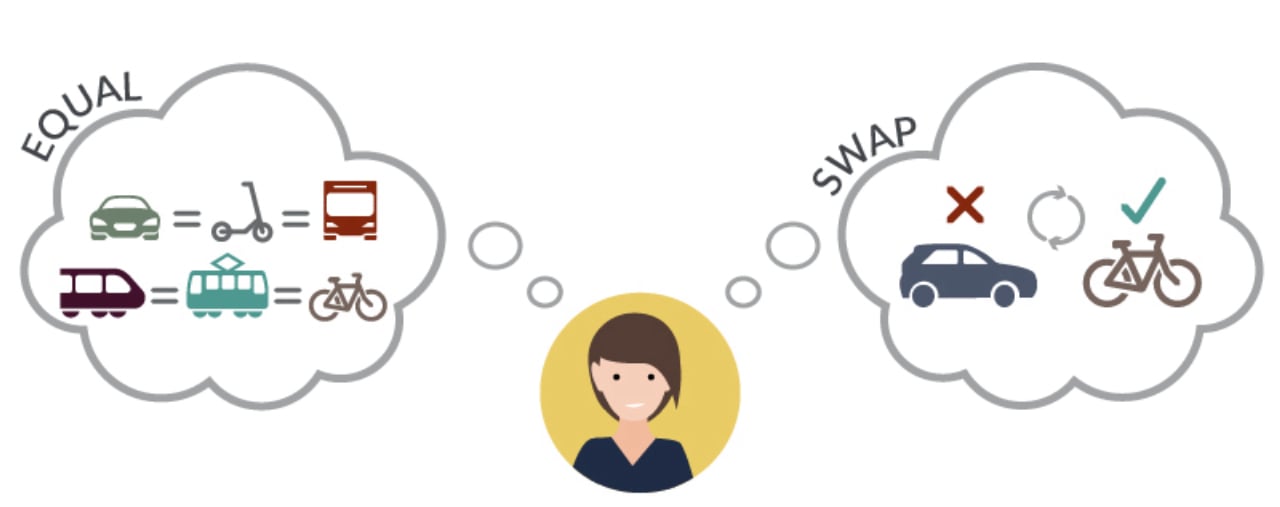
Another scenario that is being discussed a lot is that the governments may intervene to incentivize certain areas of the economy, such as the automotive industry. This is especially so in countries like Germany and Italy where automotive is a large part of the GDP.
The benefits of this would be two-fold: as well as boosting the local industry, it could help get the population mobile and commuting back to work at a time when people may remain reluctant to use public transport. Especially if it takes time for public or shared transport services to come fully back on-line.
However, this would again see increased pressure on cities already struggling with the volume of traffic. Too much emphasis on the economic incentivization of private transport added to people’s existing anxiety about using shared transport would have a cumulative negative impact – not just on traditional public transport, but also on schemes such as an urban scooter or cycle hire.
This is where urban mobility planners could push for a more sustainable effect by motivating car users to get more active instead. Regular car users have already shifted away from using their cars on the weekends – showing that they are willing to turn to alternative modes of transport. Rather than cherry-picking certain mobility industries over others, governments can jump on this new trend to encourage people to continue this activity into weekday travel as well – thereby producing a more balanced urban ecosystem.
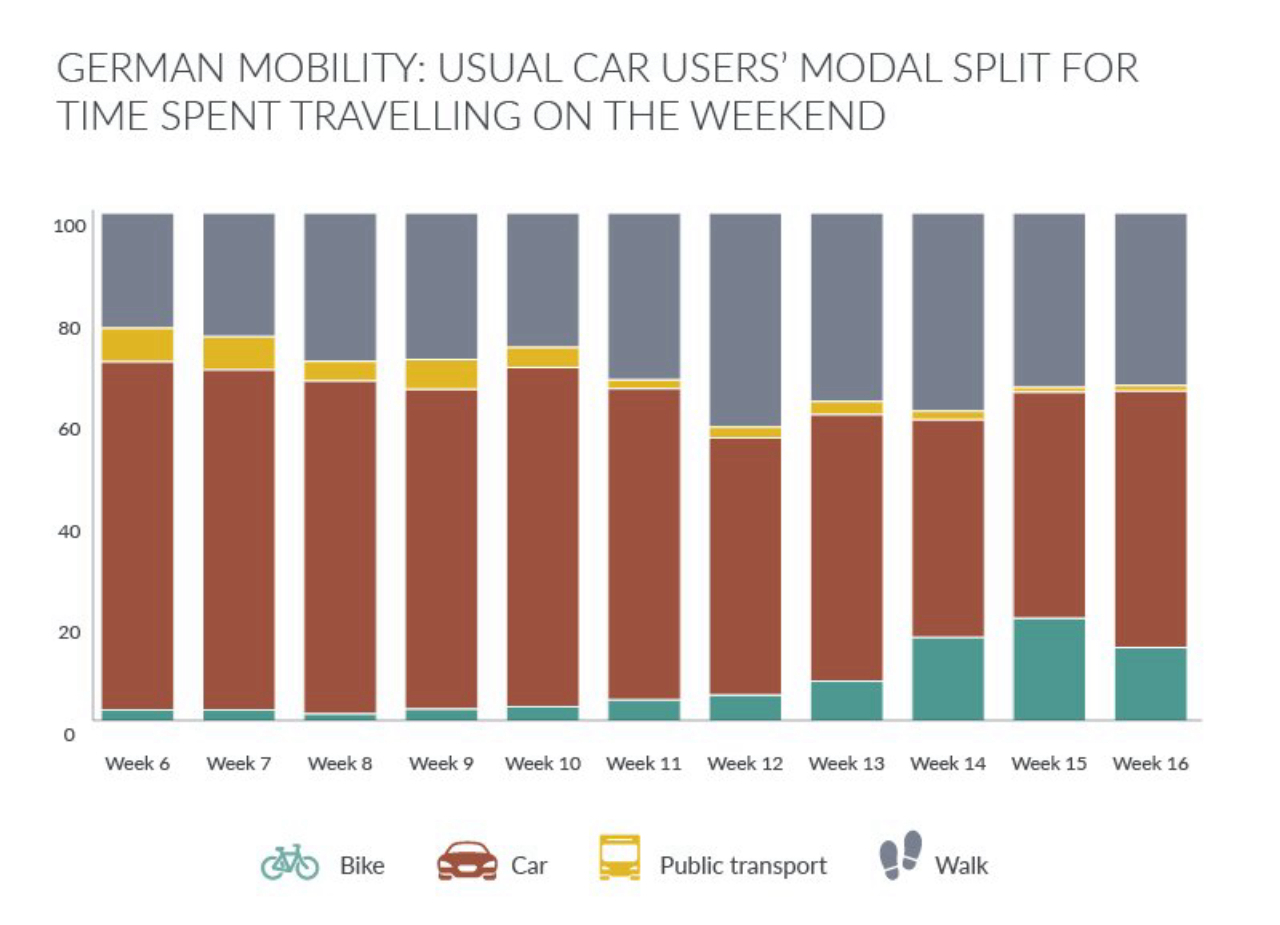
Source: MOTIONTAG (Chart shows the allocation of time by regular car users on weekends)
Another consideration for shared travel services is how they would remain competitive – especially shared closed vehicles. For example, they would need new pricing models, such as pay per day, instead of by minutes, with more collaboration between private shared mobility providers and public authorities. If these travel options do not react fast with positive offers, they will disappear – leading to even more pressure to use options like cars.
Any government incentives must pay attention to the wider ecosystem of post-lockdown urban mobility. For instance, if train or bus routes are cut, or just slow to reform at their previous levels, the people most hit will be urban workers who have no private transport means. Even during social distancing, households in Germany with limited disposable income were using public transport to the same extent as previously.
Future #3: A rise in country life mobility
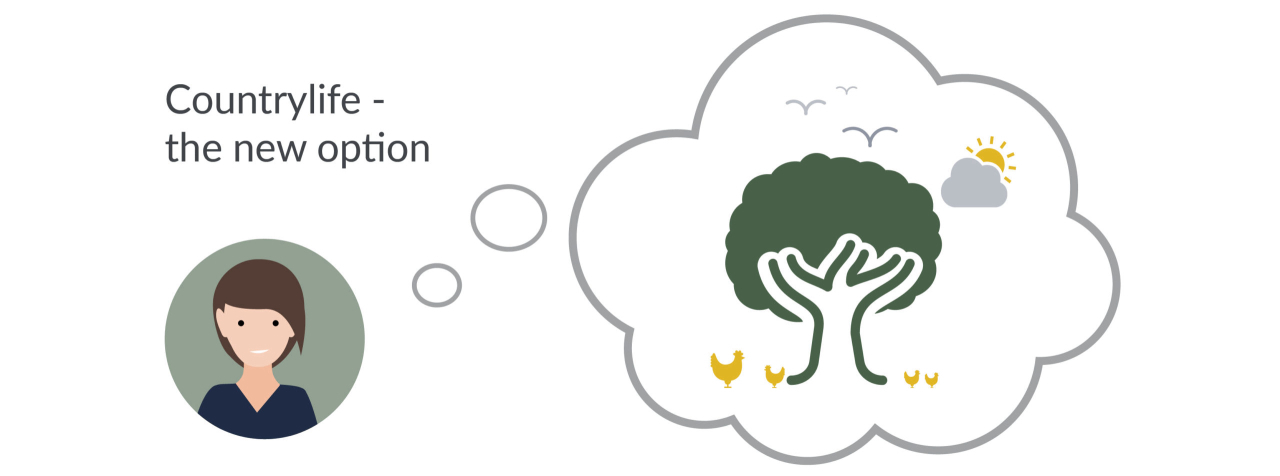
Up to now, where we live has been dictated largely by our job and office location. However, during the pandemic, an increasing number of employers started to set up to work from home. In April, 20% of Germans reported that they are working from home. On top of that, almost 20% recently stated that they will be less on the move after the coronavirus crisis than they were before.
We can assume that this is linked to workers and businesses aiming to continue working from home for some days of the week, even after lockdown is lifted. If this is the case, people will start reassessing whether it is necessary to live close to the city centers where they work, or whether they can accept a longer commute thanks to fewer days on which that commute has to take place. Other quality aspects, such as family roots, air quality, housing cost, and space can play a much more prominent role in the choice of our residence.
The long-term impact of this is that urbanization could well slow to a certain extent, as more people are able to consider living further outside the cities. Urban commuter volume would reduce during rush hours, while suburban commuting would increase on the most popular in-office days – potentially Tuesday through Thursday.
For public transport, the pressure would be on to understand these new commuter patterns and tweak their offering, frequency, and capacities to match. If this tweaking takes too long or does not work, the imminent risk would be that suburban commuters would turn to their cars instead, leading to increased congestion of road arteries into the cities.
There would also be a change in when and why people travel ‘downtown’. Reduced commuting would mean people have money to use on going out, visiting friends, etc. – and may well splash out on more expensive travel options, thanks to the regular saving on their commuting costs. Factors like flexibility or convenience might start to trump the price rationale for these trips.
What the specialists say:
The current restrictions have demonstrated to many office-based businesses that they can operate with their staff working from home. With this now proven, more people will want to continue working from home as part of their regular routine – and they already will have the technology in place to do this. From a business manager / owner perspective, they have seen that productivity can be maintained even though teams are not in the office – and are likely to start considering the savings that they could make on office space and utility bills. This is likely to lead to a permanent reduction in commuting type behaviors for certain industry sectors.
– Director of Modelling & Appraisal, UK
Future #4: More preference for local proximity
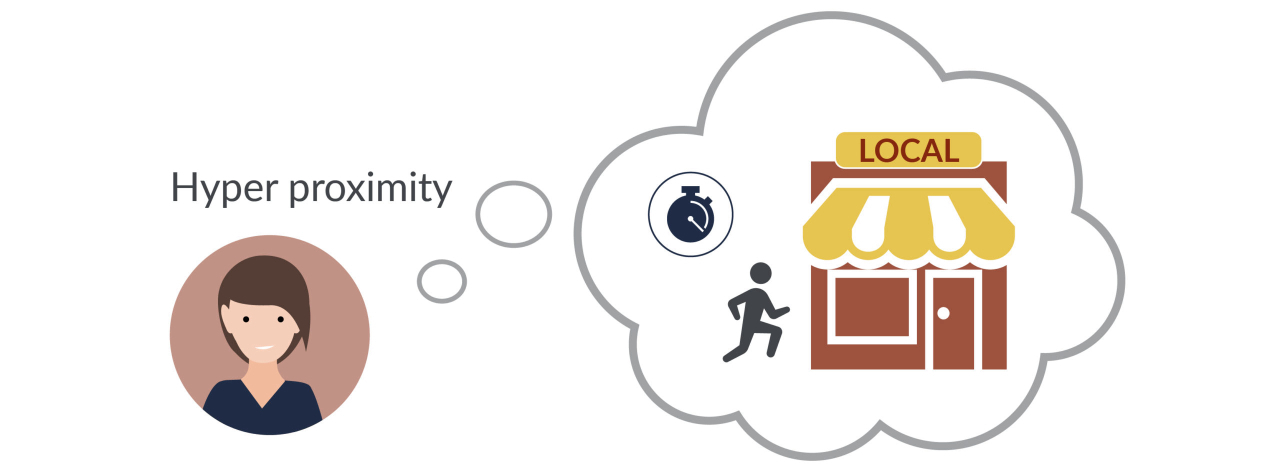
During lockdown, consumers have come to appreciate, more than ever before, how valuable it is to be able to shop for everything close to home. Particularly in cities, people have radically reduced their mobility radius and thoroughly explored their reduced catchment area by foot and on the bike.
This has meant they have much better knowing that before on what shops are available around them. Confronted with closures and limited supplies, we’ll do what we can to support the businesses that we most want to survive COVID-19. And, for many people, that will be their newly appreciated local shops.
On top of this, 36% of Germans expect their financial situation to deteriorate over the next 12 months. This, combined with some degree of ongoing travel restrictions, has already lead many people to cancel planned holiday trips. All of this adds to the increased importance of our local neighborhood, and our readiness to holiday at home or ‘staycation’.
The implications of this scenario are already visible, with local communities coming up with initiatives to support shops, bars, and restaurants in their neighborhoods. People have learned that these are worth protecting, and this will have a lasting impact on where people spend their time and money for leisure and shopping going forwards. It might even influence how close to home they look for work.
For the post-lockdown urban mobility landscape, this means that people will reconsider the different transport modes they choose to match their changed behavior. For example, the number of people who say they plan to increase their bicycle usage in a month’s time is rising even now.
For local neighborhood travel, people will rely on micro-mobility solutions and local sharing offers like cargo e-bikes. At the same time, they will still have a need for longer distances, both within their city and beyond. For these, they will want to maintain all the wider transport options, although the purpose of these trips is likely to be less about shopping and more about leisure or social visits.
In this possible future, the challenge for urban planners and city officials will be to create a fruitful environment and travel services that allow businesses to thrive in de-centralized urban centers.
What the specialists say:
“Buying local” will be a fostering trend. People have discovered new things in their neighborhood during Corona times, which would, most probably, not have been discovered without the current limitations. These hidden jewels that have supplied their needs during the difficult times of lockdown will continue to rank highly in people’s loyalty in the long-term.
– Marcus Anders, Managing Director, SWARCO Traffic Systems, Germany
Hyper proximity is a naturally observed phenomenon in any community where essential and additional services are available in the immediate vicinity. If people can rely on a local supermarket, online retail, a kindergarten or school nearby, they will naturally spend more time in their neighborhoods. We will see urban planning nudging residents towards hyper proximity, and post-Corona times will only accelerate this.
– Justas Petronis, Product Marketing Manager, Trafi, Lithuania
What will be the future for urban mobility post-lockdown?
Out of the four scenarios, all are possible, but all are not equally desirable. Our key takeaway is that urban mobility planners have an opportunity right now to influence which way these trends go. In our next blog in this series, we will go into our experts’ recommendations for urban planners to foster desirable behavior and avoid unwanted scenarios.
About our partner: MOTIONTAG creates value from motion data by providing anonymized insights into travel behaviors. This allows our clients to evaluate the profitability of actions – for example, by knowing what incentives are effective in curbing mobility-related CO2 emissions and steering policymaking with precise, real-time data.
Learn more about Urban Mobility



